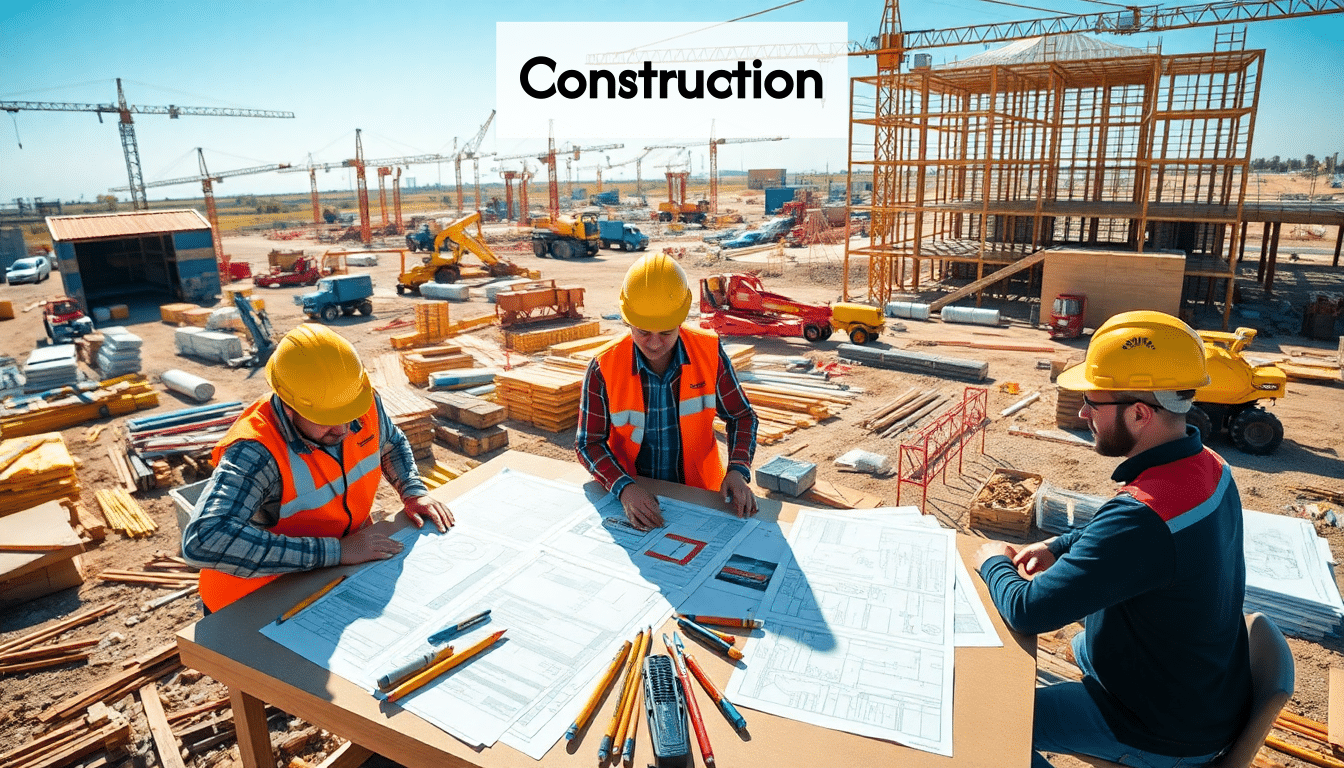The building and construction industry is booming—expected to reach a staggering $15 trillion globally by 2025. But here’s the surprising part: it’s not just about the physical labor; it’s a complex ballet of planning, technology, and safety. In fact, the real magic happens before the first nail is driven, with rigorous pre-construction planning laying the groundwork for success. Understanding this intricate process can save you money and time, and open up a world of opportunities whether you’re building your dream home or considering a career in this dynamic field.
Understanding the Building Process
Understanding the building and construction work process is essential whether you’re planning to build your dream home, manage a construction project, or considering a career in the field. The construction industry operates on well-established methodologies that ensure safety, efficiency, and quality in the finished product.
Pre-Construction Phase: The Critical Foundation
Every successful construction project begins long before the first shovel hits the ground. The pre-construction phase establishes the framework for the entire project and typically includes planning, design development, obtaining necessary permits, and securing financing. According to research from StrategicERP, thorough planning during this stage prevents costly delays and budget overruns later in the project.
During this phase, construction workers and building professionals collaborate with architects and engineers to review plans, identify potential challenges, and develop solutions before construction begins. This teamwork is crucial for identifying issues like soil conditions, drainage requirements, and structural considerations that could impact the build.
Construction Execution: From Foundation to Finish
Once planning is complete, the physical building and construction work begins. This process typically follows a logical sequence:
- Site preparation and foundation work
- Structural framing (using steel, wood, or concrete)
- Exterior systems installation (roofing, siding, windows)
- Interior rough-ins (electrical, plumbing, HVAC)
- Interior finishing (drywall, flooring, fixtures)
Each step requires specific skills from various building construction workers. For example, the foundation work might involve excavators, concrete specialists, and laborers, while interior finishing requires painters, tile setters, and finish carpenters. What construction workers do at each stage varies significantly, with specialists handling specific aspects of the build.
Quality Control and Project Management

Throughout the building process, construction managers and supervisors ensure work meets quality standards and follows building codes. They coordinate the various trades, manage the schedule, and address issues as they arise. This coordination is essential for maintaining efficiency on a construction site.
Construction jobs involve more than physical labor. Modern building and construction work includes technological components like Building Information Modeling (BIM) and project management software that help teams visualize the project, track progress, and manage resources efficiently. These tools have transformed how construction work building projects progress, allowing for better planning and problem-solving.
Safety protocols remain paramount throughout the construction process. Workers in building construction must follow strict guidelines to prevent accidents and injuries. This includes proper equipment use, adherence to regulations, and ongoing safety training—making safety one of the most critical aspects of what is construction work today.
Understanding this process provides valuable construction jobs information whether you’re hiring professionals or considering what type of work is construction as a career path. The building industry offers diverse opportunities for those with various skills and interests, from hands-on building labors to technical and management roles.
Key Takeaways
| Takeaway | Explanation |
|---|---|
| Pre-Construction Planning is Crucial | Thorough planning in the pre-construction phase can prevent costly delays and budget overruns, making collaboration between construction workers, architects, and engineers essential. |
| Embrace Technology in Construction | Digital tools like Building Information Modeling (BIM) and mobile applications streamline project management, improve communication, and enhance efficiency in the construction process. |
| Safety Standards are Essential | Adhering to OSHA regulations and implementing site-specific safety plans are vital for protecting workers and ensuring compliance, ultimately contributing to employee retention and productivity. |
| Diverse Career Opportunities Exist | The construction industry offers various career paths, from skilled trades and construction management to specialized roles in technology and sustainability, appealing to different skill sets and interests. |
| Continuous Education Keeps You Competitive | Staying updated through training and certifications is essential in the evolving construction industry, ensuring workers remain relevant and can advance their careers. |
Innovations in Construction Technology
The building and construction work industry is experiencing a technological revolution that’s transforming traditional practices and creating new opportunities for efficiency, safety, and sustainability. These innovations are changing what construction workers do and how construction work building projects are executed.
Digital Transformation in Construction
Digital tools have become essential components of modern building and construction works. Building Information Modeling (BIM) stands at the forefront of this transformation, allowing teams to create detailed 3D models that contain comprehensive information about every aspect of a project. According to research from PlanRadar, BIM and construction software received 19% of all technology investments in the construction industry over the past three years, highlighting their growing importance.
These digital platforms enable better coordination among workers in building construction by providing a centralized location for project information. Everyone from architects to building construction workers can access up-to-date plans, make real-time adjustments, and visualize the project before physical work begins. This digital approach to construction building work significantly reduces errors, improves communication, and streamlines project management.
Mobile applications have also revolutionized what is construction work today. Construction teams now use specialized apps for everything from time tracking and safety inspections to material management and quality control. These tools put critical information at the fingertips of construction labor workers, enabling faster decision-making and improved documentation.
Automation and Robotics
Automation is gradually changing what type of work is construction professionals perform. Robots and autonomous equipment are taking over repetitive and dangerous tasks, allowing human workers to focus on more skilled aspects of building and construction job responsibilities.
Drones have become invaluable tools for site surveys, progress monitoring, and safety inspections. They provide aerial perspectives that were previously difficult or expensive to obtain, helping construction managers make better-informed decisions about their projects.
Prefabrication and modular construction represent another significant shift in construction methodology. These approaches move much of the building process off-site to controlled factory environments, where components are manufactured with precision before being transported to the construction site for assembly. This not only improves quality control but also significantly reduces construction time, waste, and on-site safety risks.
Sustainable Building Technologies

The focus on environmental responsibility has spurred numerous innovations in what does construction do with materials and methods. Sustainable building practices are becoming standard in the industry, with new technologies enabling more efficient resource use.
Energy-efficient systems, including advanced HVAC technologies, smart lighting, and improved insulation materials, are reducing the environmental impact of buildings throughout their lifecycle. These innovations offer building owners long-term operational savings while reducing carbon footprints.
New construction materials are also changing the landscape of building and construction work. Engineered wood products, high-performance concrete formulations, and recycled materials offer improved durability and reduced environmental impact compared to traditional options.
These technological advancements are reshaping what is a construction job today. Modern construction professionals need technological literacy alongside traditional building skills. Understanding how to work with digital tools, automated equipment, and advanced materials is becoming essential for building labours and managers alike.
For those considering work in construction site environments or looking to advance their careers, embracing these innovations provides a competitive edge in an industry that continues to evolve with technology. Construction jobs information increasingly highlights the need for both technical knowledge and adaptability as the industry continues its technological transformation.
Essential Tools and Techniques
Successful building and construction work requires access to the right tools and knowledge of proper techniques. Whether you’re a professional in the field or a DIY enthusiast tackling home projects, understanding these essentials will help ensure quality results and safety.
Core Tools for Building and Construction
Every construction worker relies on a set of fundamental tools that form the backbone of their daily work. These tools vary depending on specialization, but several are universal across most building and construction jobs.
Measuring and layout tools are critical for accuracy in construction work building projects. As the old adage goes, “Measure twice, cut once” – a principle that prevents costly mistakes. Quality tape measures, levels, squares, and chalk lines help workers in building construction establish precise dimensions and alignments. According to The Otto House, accurate measurement tools like laser levels and quality tape measures are worth investing in, as they significantly reduce errors during construction.
Power tools have revolutionized what construction workers do on site, dramatically increasing efficiency and precision. Drills, circular saws, nail guns, and concrete mixers allow construction labor workers to complete tasks in a fraction of the time required by manual methods. These tools represent a significant investment for professionals but deliver substantial returns through improved productivity.
Specialty tools serve specific functions in building and construction works. Plumbers use pipe wrenches and cutters, electricians rely on wire strippers and voltage testers, and masons need trowels and floats. Understanding what type of work is construction specialists perform helps identify the appropriate tools needed for specific tasks.
Safety equipment isn’t just a legal requirement—it’s essential for protecting what is a construction job’s most valuable asset: the worker. Hard hats, safety glasses, gloves, and appropriate footwear are non-negotiable basics for anyone involved in construction building work. Specialized safety equipment like fall protection harnesses, respirators, and hearing protection may also be necessary depending on the specific building and construction job.
Effective Construction Techniques
Beyond tools, mastering proper techniques is what distinguishes skilled construction professionals. These methods have evolved over generations and continue to adapt as new materials and technologies emerge.
Proper material handling techniques prevent damage to building materials and reduce the risk of injury. This includes everything from correctly stacking lumber to safely transporting heavy materials using equipment like forklifts and cranes. Understanding these fundamentals is crucial for anyone wondering what does construction do with various materials.
Construction sequencing—knowing the proper order of operations—ensures efficiency and quality. For example, roughing in electrical and plumbing must occur before closing up walls with drywall. This sequential approach is fundamental to how does construction work in professional settings.
Quality control techniques help maintain standards throughout the building process. This includes regular inspections, material testing, and adherence to building codes. Building laborers and supervisors must work together to implement these practices consistently.
Moisture management is critical in any construction project. Proper flashing, waterproofing, and drainage solutions protect structures from water damage—one of the most common and costly issues in construction. Workers in building construction must understand these techniques to ensure the longevity of their work.
Mastering these essential tools and techniques provides a solid foundation for anyone involved in building and construction works. Whether you’re a seasoned professional or just starting your journey in construction jobs, continuous learning and adaptation to new methods remains key to success in this dynamic field.
Safety Standards and Regulations
Safety is paramount in building and construction work. The industry’s physical nature and complex environments present numerous hazards that require strict adherence to established safety standards and regulations. Understanding these requirements is essential for everyone involved in construction work building projects, from managers to front-line workers.
OSHA Requirements and Compliance
In the United States, the Occupational Safety and Health Administration (OSHA) establishes and enforces safety standards for construction sites. These regulations cover everything from fall protection and scaffolding requirements to electrical safety and hazard communication. Compliance with OSHA standards isn’t just a legal obligation—it’s a fundamental aspect of what is construction work in America.
Construction companies must implement comprehensive safety programs that include regular training, hazard assessments, and proper documentation. What construction workers do to maintain safety includes participating in regular toolbox talks, safety meetings, and specialized training for specific hazards they might encounter.
According to research from Acuity International, 75% of workers are more likely to stay with companies that prioritize physical safety. This statistic highlights how safety standards affect not just worker wellbeing but also employee retention and overall productivity in the construction industry.
Personal Protective Equipment (PPE)
Personal protective equipment forms the last line of defense against workplace hazards for workers in building construction. Required PPE typically includes:
- Hard hats to protect against falling objects and head injuries
- Safety glasses or face shields for eye protection
- Gloves appropriate for specific tasks and materials
- Steel-toed boots to prevent foot injuries
- High-visibility clothing to ensure workers remain visible
Specialized work may require additional PPE such as respirators for dust or chemical exposure, fall protection harnesses for work at heights, or hearing protection in noisy environments. Employers must provide appropriate PPE and ensure workers understand how and when to use it correctly—a crucial component of construction jobs information for new hires.
Site-Specific Safety Plans
Site-specific safety plans tailor general safety standards to the unique characteristics and hazards of each construction project. These plans identify potential risks at specific construction sites and outline control measures to mitigate them. They also establish emergency procedures, communication protocols, and responsibilities for building and construction job supervisors and workers.
What type of work is construction determines many of the specific safety requirements. For example, high-rise projects require extensive fall protection systems, while excavation work needs trench safety measures. These customized approaches ensure that safety protocols address the actual risks present rather than applying generic solutions.
Safety Culture and Training
Beyond mere compliance with regulations, successful construction companies foster a strong safety culture where what do you do as a construction worker includes looking out for yourself and your colleagues. This culture begins with leadership commitment and extends through every level of the organization.
Comprehensive training ensures that building laborers understand not just safety rules but why they matter. This includes:
- Initial safety orientation for all new workers
- Task-specific training for specialized work
- Regular refresher training to reinforce safety practices
- Emergency response training for potential crisis situations
Effective communication channels between management and construction labor workers facilitate reporting of near-misses and hazardous conditions before they cause injuries. Many companies implement safety incentive programs that reward workers for maintaining safe practices rather than punishing violations after the fact.
By prioritizing safety standards and regulations, companies demonstrate their commitment to protecting their most valuable asset—their workforce. This commitment not only reduces workplace injuries and illnesses but also improves quality, productivity, and morale throughout work in building construction environments.
Career Opportunities and Training
The building and construction work industry offers diverse career paths with substantial growth potential. Whether you’re just starting out or looking to advance your current position, understanding the available opportunities and required training can help you build a rewarding career in this dynamic field.
Entry Points and Career Progression
One of the most appealing aspects of construction jobs is the variety of entry points available. Many positions in building and construction work don’t require advanced degrees, making the industry accessible to those with different educational backgrounds.
Apprenticeship programs provide structured pathways into skilled trades like carpentry, electrical work, plumbing, and masonry. These programs combine classroom instruction with paid on-the-job training, allowing you to earn while you learn. Apprentices work alongside experienced professionals, gradually taking on more responsibility as they develop their skills in building and construction works.
Skilled trades offer clear progression paths. What construction workers do typically evolves as they gain experience, moving from apprentice to journeyman and potentially to master craftsman status. From there, many advance into supervisory positions, managing teams of workers in building construction projects.
Construction management represents another career track within the industry. This path might begin with entry-level positions such as assistant project manager before progressing to project manager, construction supervisor, and eventually executive positions. While some construction managers rise through the ranks with practical experience, many enter the field with degrees in construction management, civil engineering, or related fields.
Specialized Career Paths
The construction industry encompasses numerous specialized roles beyond general construction labor workers. Understanding what type of work is construction specialists perform can help you identify areas that match your interests and aptitudes:
- Building Information Modeling (BIM) Specialists combine construction knowledge with technology skills to create and manage digital representations of building projects
- Construction Estimators calculate project costs, requiring strong analytical and mathematical abilities
- Building Inspectors ensure compliance with codes and regulations, drawing on extensive knowledge of construction standards
- Heavy Equipment Operators specialize in operating machinery like excavators, bulldozers, and cranes
- Green Building Specialists focus on sustainable construction practices and technologies
These specialized paths demonstrate the breadth of what is a construction job today, offering options that combine practical skills with technical knowledge. According to Source and Recruit Company, successful careers in technical fields require both specialized technical skills and strong soft skills like problem-solving, communication, and adaptability—a principle that applies equally to construction careers.
Training and Certification Requirements
The training requirements for building and construction job positions vary widely. Some entry-level positions require only a high school diploma and on-the-job training, while others demand extensive education and certification.
Industry certifications provide recognized credentials that validate your expertise in specific areas of construction work building. These may include:
- OSHA safety certifications
- Trade-specific certifications in electrical, plumbing, or HVAC work
- Project management certifications like the PMP (Project Management Professional)
- Green building certifications such as LEED (Leadership in Energy and Environmental Design)
Community colleges and technical schools offer programs specifically designed for construction trades, ranging from certificate programs to associate degrees. These programs provide foundational knowledge for work in construction site environments while developing practical skills through laboratory and hands-on experiences.
Four-year degree programs in construction management, civil engineering, or architecture prepare students for higher-level positions in the industry. These programs typically include coursework in project scheduling, cost estimation, building codes, and contract administration—all essential for understanding how does construction work at a management level.
Continuing Education and Skill Development
The construction industry constantly evolves with new materials, techniques, and technologies. Continuing education is essential for building laborers and managers alike to remain competitive and advance their careers.
Industry associations offer workshops, seminars, and online courses covering everything from specific construction techniques to management practices. These resources provide valuable construction jobs information while facilitating networking with other professionals.
Technology training has become increasingly important as digital tools transform what do you do as a construction worker. Familiarity with project management software, digital blueprints, and emerging technologies like augmented reality can significantly enhance your value to employers.
By pursuing relevant training and certification opportunities, you can build a rewarding career in construction that offers stability, competitive compensation, and the satisfaction of creating lasting structures that serve communities for generations.
Frequently Asked Questions
What is the pre-construction phase in building and construction work?
The pre-construction phase is a critical foundation for any construction project, involving planning, design development, obtaining permits, and securing financing. Successful planning during this phase can prevent costly delays and budget overruns.
What are the essential tools needed for construction work?
Essential tools for construction work include measuring and layout tools (like tape measures and levels), power tools (such as drills and saws), specialty tools relevant to specific trades, and safety equipment like hard hats and gloves to protect workers on the job site.
How does technology impact modern construction?
Technology impacts modern construction through tools like Building Information Modeling (BIM) and mobile applications, which enhance project management, improve communication, and allow for better planning and coordination among construction workers.
What safety regulations must be followed in construction?
Construction safety regulations include adhering to OSHA standards, providing personal protective equipment (PPE), and implementing site-specific safety plans to address unique project hazards. Regular training and a strong safety culture are essential for compliance and worker protection.
Unlock Your Construction Career Potential Today!
Navigating the complexities of the building and construction industry can be daunting. From the critical pre-construction phase highlighted in our practical guide to the detailed execution and quality control phases, understanding the full scope of the process is essential. Yet, for many skilled professionals, finding the right job placements in this rapidly evolving field often feels overwhelming.
At The Amundson Group, we connect talented construction pros with exceptional career opportunities across various sectors, including heavy civil, commercial, and more! Our extensive network ensures that you’re not just another candidate; you’re part of a mission to build something great, leveraging valuable insights and industry partnerships.
!
Are you ready to transform your construction career and find a fulfilling position that values your expertise? Don’t wait for opportunities to pass you by—visit Amundson Group now and explore our recruitment services that prioritize your goals and aspirations. Join us on a journey towards your dream job in construction today!






